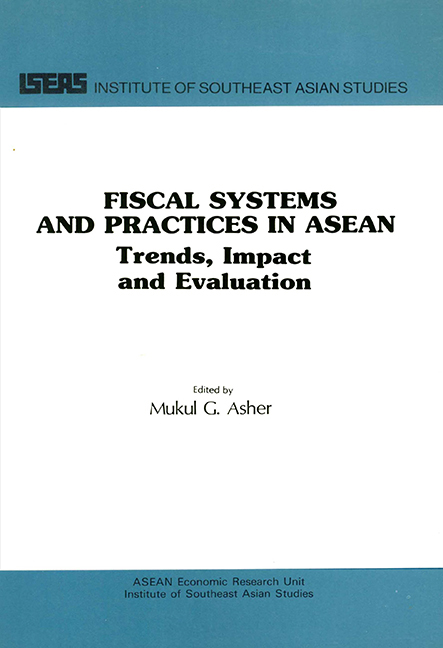Book contents
- Frontmatter
- Contents
- List of Tables
- List of Figures
- Acknowledgements
- 1 A Comparative Overview of ASEAN Fiscal Systems an Practices
- 2 Fiscal System and Practices in Indonesia
- 3 Fiscal System and Practices in Malaysia
- 4 Fiscal System and Practices in the Philippines
- 5 Fiscal System and Practices in Singapore
- 6 Fiscal System and Practices in Thailand
- THE EDITOR
1 - A Comparative Overview of ASEAN Fiscal Systems an Practices
Published online by Cambridge University Press: 21 October 2015
- Frontmatter
- Contents
- List of Tables
- List of Figures
- Acknowledgements
- 1 A Comparative Overview of ASEAN Fiscal Systems an Practices
- 2 Fiscal System and Practices in Indonesia
- 3 Fiscal System and Practices in Malaysia
- 4 Fiscal System and Practices in the Philippines
- 5 Fiscal System and Practices in Singapore
- 6 Fiscal System and Practices in Thailand
- THE EDITOR
Summary
After several earlier short-lived attempts at formation of a regional organization, the Association of Southeast Asian Nations (ASEAN), formed in 1967, has endured. Moreover, as Crone has noted, “… few would nowforesee the collapse of ASEAN, despite criticisms of its performance” (1988, p. 33).
While ASEAN has spawned an extensive literature, particularly in the areas of trade and foreign investment, fiscal systems and practices have received less attention. Few studies which have been undertaken in this area have focused on tax and fiscal incentive aspects (Asher and Booth 1983;Shome 1986; O'Reilly 1989; Asher 1989), or on particular aspects such as social security and privatization.
This study is motivated by the desire to help fill this gap in the existing literature on ASEAN. It focuses on the fiscal systems and practices in the five original members of ASEAN, namely, Indonesia, Malaysia, Philippines, Singapore and Thailand. The sixth member, Brunei, is excluded. It joined ASEAN on 1 January 1984. It is a tiny but oil rich state with a population of only 0.2 million but a per capita income of more than US$20,000. While Brunei does levy a company income tax (at a rate of 30 per cent) and a tax on petroleum operations (at a rate of 55 per cent), it does not levy any individual income tax. It also does not levy taxes on sales, property, payroll, or capital gains. Stamp duties, customs duties, and excises on liquor and tobacco are, however, levied.
Each country paper discusses central government revenue and expenditure levels and structure; budget balance and its financing; probable economic impact of the fiscal system on resource allocation, incentives and growth; equity; stabilization; and revenue productivity. Each paper also provides indications concerning the future direction of the fiscal system in the concerned country.
This chapter provides a comparative overview of the fiscal systems and practices in the ASEAN countries. It has three main objectives. The first is to describe the various techniques used in the country papers to estimate revenue productivity.
- Type
- Chapter
- Information
- Fiscal System and Practices in ASEANTrends, Impact and Evaluation, pp. 1 - 18Publisher: ISEAS–Yusof Ishak InstitutePrint publication year: 1989

